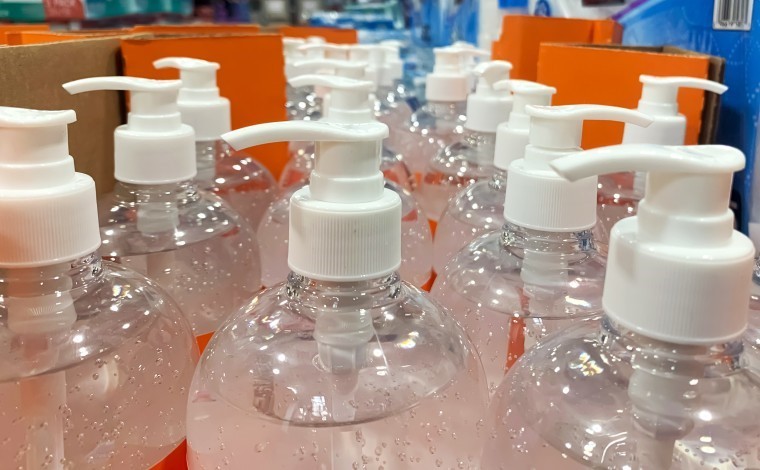
In the early months of the pandemic, businesses raced to produce and distribute face masks, medical supplies, hand sanitizer and other goods that were suddenly scarce, shockingly expensive or unavailable at any price.
Companies large and small responded to the need and pivoted to fill these new demands, even as many of them were also coping with drastic reductions in sales and mounting losses. But as the science around the coronavirus has evolved and the immediate supply shock of those early days is now in the past, some of these businesses find themselves with merchandise they can’t sell — or even give away, in some cases — or stockpiles of raw materials filling their homes or production facilities.
“I’ve been writing about risk in supply chain forever, [and] never seen anything like this,” said Eric O'Daffer, a research vice president in the health care supply chain group of consulting firm Gartner. “Some companies pivoted their whole product lines.”
In the early months of the pandemic, companies were motivated by a sense of social responsibility as well as their bottom line.
Maya Cata had owned a vintage clothing shop on Etsy for 12 years, but when the pandemic hit, the Omaha-based entrepreneur taught herself to sew and set up a second shop called Mod Masks.
Cata said she struggled with pricing her face masks, for which she charges about $14 each. “I know I can't compete with stores like Old Navy or major retailers that manufacture in China,” she said. “Even designers like Kate Spade are charging less than what I'm charging.” Cata said she found a successful niche by sourcing fabric with artsy, esoteric or vintage-inspired prints as a way to differentiate herself without having to compete on price.
Managing her inventory of that material, though, has been a learning curve. “I had purchased a lot at the beginning of the pandemic… I was constantly buying fabric,” she said. “I have a pretty big kitchen, so I have fabric in my kitchen cabinets.”
In April 2020, Etsy CEO Josh Silverman told CNBC that around 20,000 shops on the platform were selling face masks. Some are now finding that the initial surge of demand they experienced faded more quickly than they expected, particularly after the Centers for Disease Control and Prevention announced in the spring that fully vaccinated people no longer needed to wear masks in many circumstances.
“It caught us by surprise. It made demand go down significantly over the end of May, in June and July,” said Kumar Mata, who owns a dry cleaning company in suburban Washington, D.C., and began selling masks last year to keep some revenue coming in and so he could keep a seamstress employed.
“The market has been a rollercoaster this year for mask makers,” he said.
Mata said he finds that imports have undercut sales of his own masks, which are made in-house and sold for between $8 and $12 on his Etsy store, Virginia Tailors. “I don't know how to get rid of my inventory now,” he said. “We started lowering our prices and, because we’re a traditional dry cleaner, we started giving the masks away for free to our customers.”
Andrew Hogenson, global managing partner of consumer goods, retail and logistics at Infosys Consulting, said companies couldn’t rely on the carefully calibrated formulas they usually use to predict how much of what products to make or to order from their manufacturing partners. “There's a social mandate to get as much out as you can, so all the traditional mechanisms and sophisticated systems companies have are completely ineffective,” he said. “Obviously, there's no precedent for how much PPE [personal protective equipment] you'll sell in a pandemic.”
Larger companies were not immune to the effects caused by whipsawing demand: Apparel giant Hanesbrands told investors in its final quarter of 2020 that the company was “moving on from PPE.” The company said the introduction of Covid-19 vaccines “along with slowing retail orders and a flood of competitive offerings have dramatically reduced our future sales opportunities… We’ve made the difficult, but important decision to write down our entire PPE inventory-related balance,” CEO Steve Bratspies told investors on the company’s earnings call for the final quarter of 2020.
O’Daffer said health care providers initially found themselves scrambling in response to critical shortages of masks and similar supplies. Now, they are left with "hundreds and in some cases thousands of pallets, so we’re watching write-offs happen at the provider level,” he said.
Some of these missteps might have been avoided if a robust federal response had been mounted at the outset. O’Daffer pointed out that even larger health care organizations were reduced to ad-hoc solutions. “In almost every market in the country — 300 health systems in the U.S. and they all operate locally — lots of the distilleries came up and made hand sanitizers,” he said.
Source: https://www.nbcnews.com/business/business-news/small-businesses-who-pivoted-make-masks-sanitizer-are-still-feeling-n1279767

